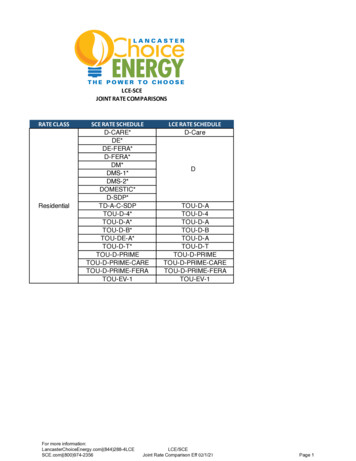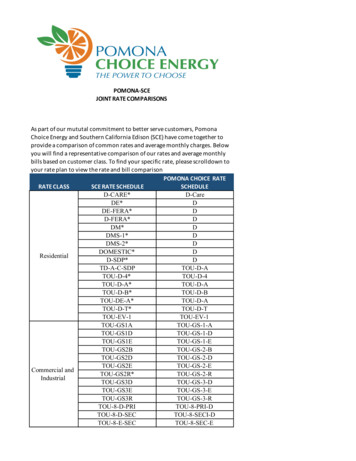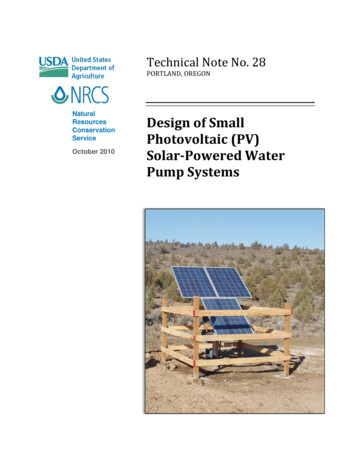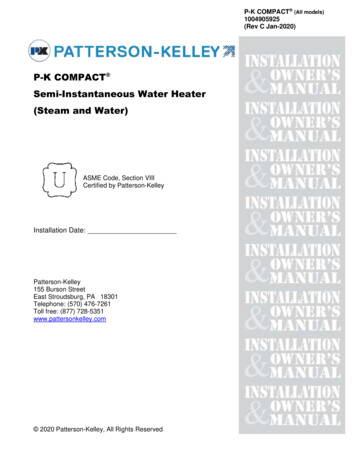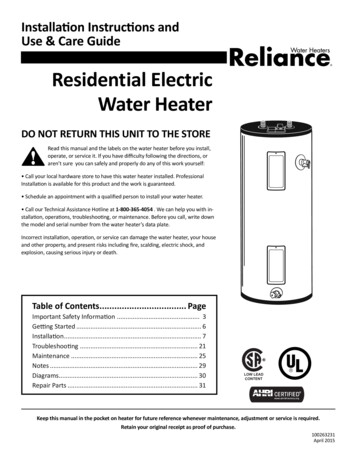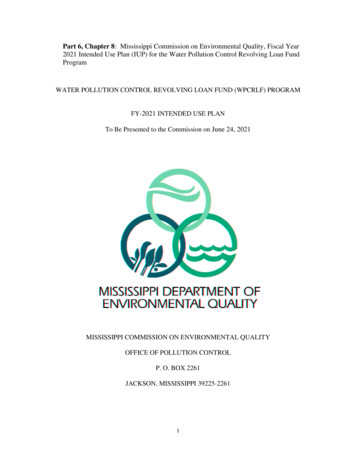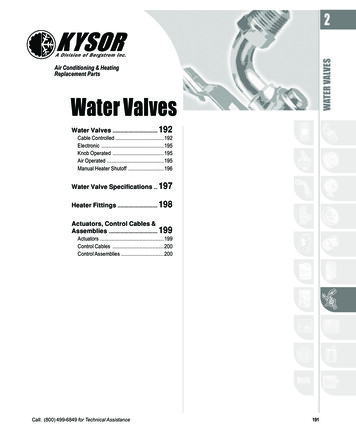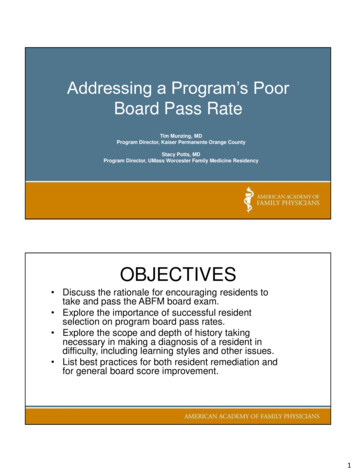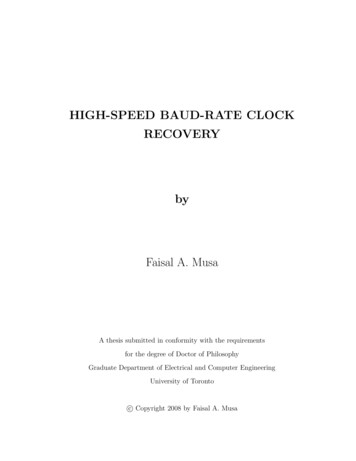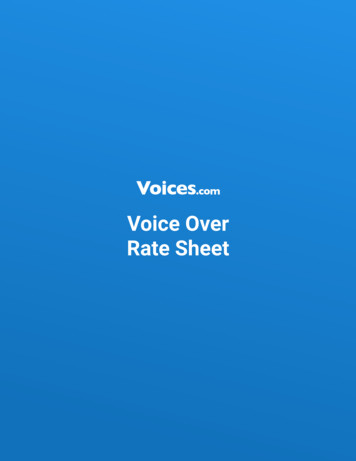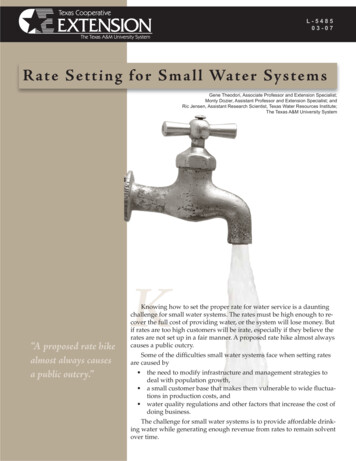
Transcription
L-548503-07R at e S e tt i ng fo r S m a l l Wat er Sys t em sGene Theodori, Associate Professor and Extension Specialist;Monty Dozier, Assistant Professor and Extension Specialist; andRic Jensen, Assistant Research Scientist, Texas Water Resources Institute;The Texas A&M University SystemK“A proposed rate hikealmost always causesa public outcry.”Knowing how to set the proper rate for water service is a dauntingchallenge for small water systems. The rates must be high enough to recover the full cost of providing water, or the system will lose money. Butif rates are too high customers will be irate, especially if they believe therates are not set up in a fair manner. A proposed rate hike almost alwayscauses a public outcry.Some of the difficulties small water systems face when setting ratesare caused by the need to modify infrastructure and management strategies todeal with population growth, a small customer base that makes them vulnerable to wide fluctuations in production costs, and water quality regulations and other factors that increase the cost ofdoing business.The challenge for small water systems is to provide affordable drinking water while generating enough revenue from rates to remain solventover time.
2Publications to Helpwith Rate SettingSeveral agencies and organizations havepublications to help with rate setting.In 2005, the U. S. Environmental Protection Agency (EPA) published a handbooktitled “Setting Small Drinking System Ratesfor a Sustainable Future.” It helps managersof small systems understand how to set ratesto reflect the full costs of providing a safe andreliable supply of drinking water to customers. The handbook recommends informingcustomers of a supplier’s water rate structureso they will understand that they are paying a fair share of the cost of providing safedrinking water. Outreach programs to educatecustomers can include mailings, announcements in newspapers, flyers and public meetings to explain why a rate increase is needed.If customers understand system finances theymay be more likely to support rate proposals.The handbook suggests this step-by-stepprocedure for developing and implementingproper water rates: Determine the full cost of doing business. Determine current revenues. Consider revenue needs (including thecost of anticipated repairs). Calculate the amount of money customersmust be charged to fully cover current andprojected costs. Evaluate various rate structures and design the appropriate rates. Implement the rates. Regularly review the rates and makechanges when appropriate.The EPA suggests that small rate increasesimplemented over a number years may bemore acceptable to customers than infrequent,large rate increases. It also recommends thatsmall water systems consider setting differentrates for various classes of water users such asresidential customers, industries, businessesand agricultural producers, because differenttypes of customers may have distinctly different water use patterns.The handbook discusses different waterrate strategies and describes circumstances inwhich each rate type might be appropriate: Flat or fixed rates charge customers thesame amount regardless of how much water they use. This may save small systemsthe expense of installing meters to recordwater use. Uniform rates charge a standard rate perunit of water used. This structure may encourage conservation because the averagecost of water does not decrease as largervolumes of water are used Decreasing block rates can be used whena system serves industrial, commercialor agricultural customers who use largeamounts of water, but this method offerslittle incentive for customers to conserve.Customers are charged lower rates perunit for fixed quantities of water. Increasing block rates charge customershigher rates per unit of water use. This ratestructure offers the greatest incentive toconserve.The 2005 handbook and other EPA reportsmake the following points: Rates should generate sufficient revenueto cover the full cost of operating a watersystem. By charging customers the full costof water, small water systems send a message that water is a valued commodity thatmust be used wisely and not wasted. Rates should be equitable, with each classof customers paying a fair share of the costof providing water service. When rates are set to cover the full cost ofproduction, water systems are more likelyto have financial stability and security. Revenues from rates should not be used tosubsidize other municipal services. If the full cost of producing and distributing water exceeds revenues, managersshould consider setting higher rates orpursuing other options such as reducingoperating costs, finding additional sourcesof revenue such as grants or loans, and restructuring (that is, purchasing water fromanother system or contracting out operations and maintenance). Rates should be viewed as short-termstrategies and reviewed periodically.
3The EPA (2005) has also published casestudies of small water systems that haveimplemented sustainable water pricing strategies. These strategies achieve full-cost pricing,improve the management of finances and assets, and focus on efficient water use. One Texas system, the Grimes & Waller (G&W) WaterSupply Corporation, was cited as an outstanding example of how small systems can addressrate issues. G&W is faced with rapid population growth as suburbs from Houston expandto its service area, and is developing a newrate structure to ensure that new customersbear much of the financial burden associatedwith expanding the system to meet increaseddemand.developing and following audits and relatedaccounting practices for water districts.Another source of information for managers is The Community Resource Group, Inc.(CRG), which has a series of fact sheets aboutrate setting and financial management. Thesefact sheets cover such topics as how to develop appropriate rates and charges; how toensure that revenues achieve a balanced budget and how to prepare, understand and use abudget; how to establish internal accountingand financial management controls to safeguard system finances; and how to work withcustomers and stakeholders to determine ifrate increases are needed. CRG advises smallwater system managers to divide expensesinto fixed and variable costs and use that datato determine the minimum water bill that canbe charged. Once this is done, rate structuresfor specific customer classes can be considered. Customers should be informed aboutwhy rate increases are needed (for example, tomeet regulations that enhance drinking waterquality and protect public health, to pay forneeded expansions or improvements, etc.).Two other resources from the EPA canbe helpful to managers. A national study ofsmall water systems (2000) recommends thatmanagers calculate their operating ratio bydividing total operating revenues by operations and maintenance expenses. Generally, aratio of less than 1.0 suggests that a system isoperating at a loss. This study shows that 30 to40 percent of small water systems operated ata loss between 1995 and 2000. A report titled“Asset Management: A Handbook for SmallWater Systems” contains strategies for funding infrastructure replacement from rates andexternal sources.The Texas Commission on Environmental Quality (TCEQ) has several reports andpublications to help small water systems withrate setting and financial management. Onefact sheet explains to customers how rates areset, which factors can be considered when arate increase is proposed and which cannot.When a privately owned small water systemapplies for a rate increase, the TCEQ assessesthe system’s ability to operate and can suggestimproved management practices. A TCEQ report titled “The Water District Financial Management Guide” (2004) contains guidelines forThe WaterSense newsletter (part of theNational Drinking Water Clearinghouse atWest Virginia University) published a seriesof articles about how to set water rates andwin approval for rate increases. The newsletter advises that involving the public early inthe process can mitigate negative publicityor ill feelings customers may have about arate hike. Managers of small systems mustidentify the specific reason a rate increase isbeing proposed and should consider holdingtown meetings and using mass media to communicate with the public about these issues(Campeon, 1996, 1995).Finally, The American Water Works Association published a handbook titled “Developing Rates for Small Systems” (2004). Themanual is specifically for systems that lackdata on customer water demands, systemwater use and physical assets the system mayown. It describes how to compile such data,develop a financial plan, and set water ratesbased on revenue requirements and expenses.University ResearchIn 2005, Greg Landreth and David Eaton ofthe LBJ School of Public Affairs at the University of Texas at Austin assessed economic, performance and management issues associatedwith small water systems throughout Texas.They studied six drinking water providersin Texas (including small and medium-sizedutilities) to compare the performance of publicand privately owned systems. The researcherslooked at the advantages and disadvantages of
4public and private water providers, includingwhether these systems have taxing authority,have power to condemn property througheminent domain, and are eligible for federaland state grants and loans. They gathered dataon the rates the systems charge, the extent towhich systems of all sizes violate state waterquality rules, and the number of state-certified treatment plant operators each systememploys on a per-customer basis. They foundthat publicly financed small water systemshave certain advantages over privately ownedsystems—primarily taxing authority, easieraccess to lower cost capital, and flexibility inhow to allocate costs.Other ResourcesSeveral other organizations provide guidance and information about rate setting.Texas Cooperative Extension, with itsnetwork of county Extension agents and statewide specialists, can work one-on-one withsmall water system managers to help themdevelop strategic plans, make financial plansand set rates.The Texas Commission on EnvironmentalQuality, the state agency with authority toconsider and approve rate increases, also helpssmall water systems with rate and financialmanagement issues. Its annual Public Drinking Water Conference is an excellent resourcefor managers. Regional TCEQ offices arelocated throughout the state.The Texas Office of Rural and CommunityAffairs (ORCA) helps small water systemsand communities manage finances and obtainfederal and state funds. ORCA has field officesin the High Plains and South Texas that canprovide on-site assistance. The agency administers the Texas Community DevelopmentBlock Grant Program, which offers grants toeligible rural and small communities to planand build such public facilities as water andwastewater projects.The Texas Rural Water Association helpssmall water system managers develop budgets, conduct rate studies and create reservefunds to pay for unanticipated expenses.TRWA has a contract with TCEQ to providefinancial, managerial and technical assistanceto small water systems.The EPA has nine research and educationcenters at universities throughout the nationto assist small water systems with such issuesas system management, capacity building andrate setting. The EPA-funded center at BoiseState University has developed a free softwareprogram (“RATE Checkup”) that helps smallwater systems set rates and prepare budgetforecasts. The center that serves Texas is located at New Mexico Tech University. In additionto other services, these centers can facilitatefocus groups and meetings with stakeholders.SummarySetting the right rates for water service isone of the most important obligations of smallwater systems. Proper rates ensure that thesesystems cover their costs while still providing affordable service. Setting fair rates buildspositive relationships with the people theyserve. Fortunately, there are many resourcesand people in Texas who can help.For More InformationAmerican Water Works Association. 2004.Developing Rates for Small Systems. Denver,Colorado.Brown, C. 2004. “Making Small Water SystemsStrong.” Journal of Contemporary Water Research& Education, 128: 27-30.Cameon, P. 1996. “Rate Increases: Dealing withthe Public.” WaterSense newsletter, publishedby the National Drinking Water Clearinghouse, West Virginia University, Morgantown,West Virginia.Cameon, P. 1995. “Rate Reviews Are Criticalfor System Finances.” WaterSense newsletter,published by the National Drinking WaterClearinghouse, West Virginia University,Morgantown,West Virginia.Community Resource Group, Inc., Fayetteville, Arkansas. Community Water Bulletin factsheet series:“Establishing Internal Controls to ProtectYour Financial Health.” No. 264.“Financial Management and Your WaterSystem.” No. 254.“Gaining Customer Support for a RateIncrease.” No. 262.“Protecting the Financial Health Your
5Small Water System Has Achieved.” No.259.“Rate Setting: How Much Should YouCharge?” No. 259.“Revenue and the Balanced Budget.” No.255.“Setting Rate Breaks and Rate Blocks.” No.261.“The Budget Process.” Nos. 254 and 255.“The Cost of Water Production.” No. 260.Texas Commission on Environmental Quality. 2004. Water District Financial ManagementGuide. Austin, Texas.Texas Commission on Environmental Quality. 2005. Report to the Governor: Public WaterSystem Capacity Development Program. Austin,Texas.Texas Commission on Environmental Quality.2006. Utility Funding & Rate Design: A Guide forCustomers of Private or Investor-Owned Utilities.Austin, Texas.Texas Office of Rural and Community Affairsand the United States Army Corps of Engineers. 2003. Utilizing Technology for Small WaterSystems in Texas. Austin, Texas.U.S. Environmental Protection Agency. 2000.Community Water System Survey. Washington,D.C.U.S. Environmental Protection Agency.
to determine the minimum water bill that can be charged. Once this is done, rate structures for specifi c customer classes can be consid-ered. Customers should be informed about why rate increases are needed (for example, to meet regulations that enhance drinking water quality and protect public health, to pay for needed expansions or improvements, etc.). The Texas Commission on Environmen
